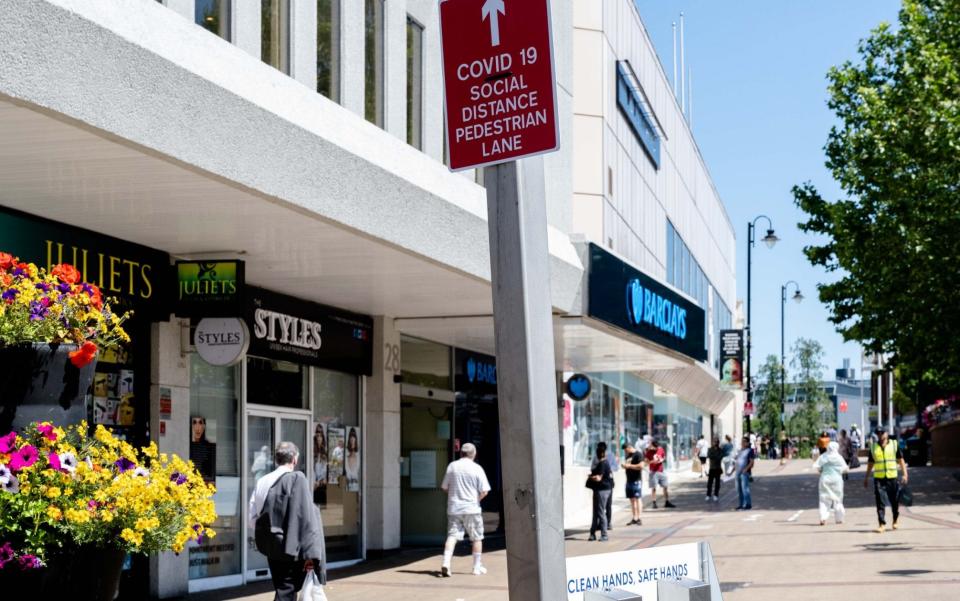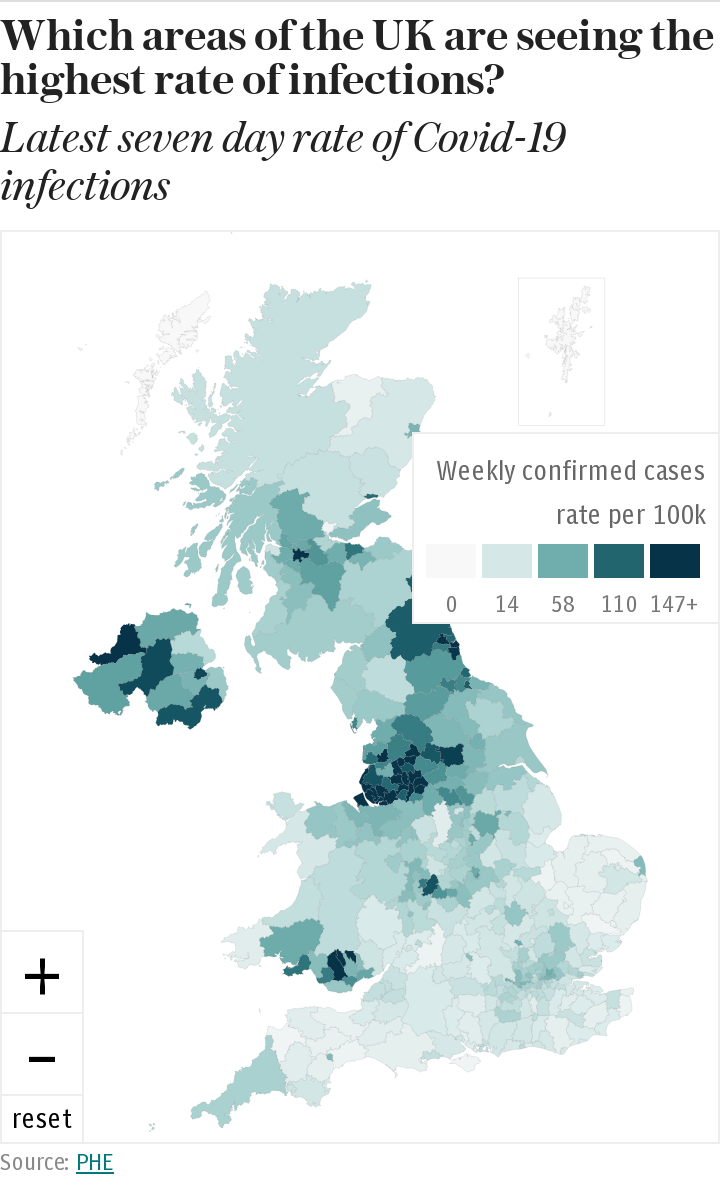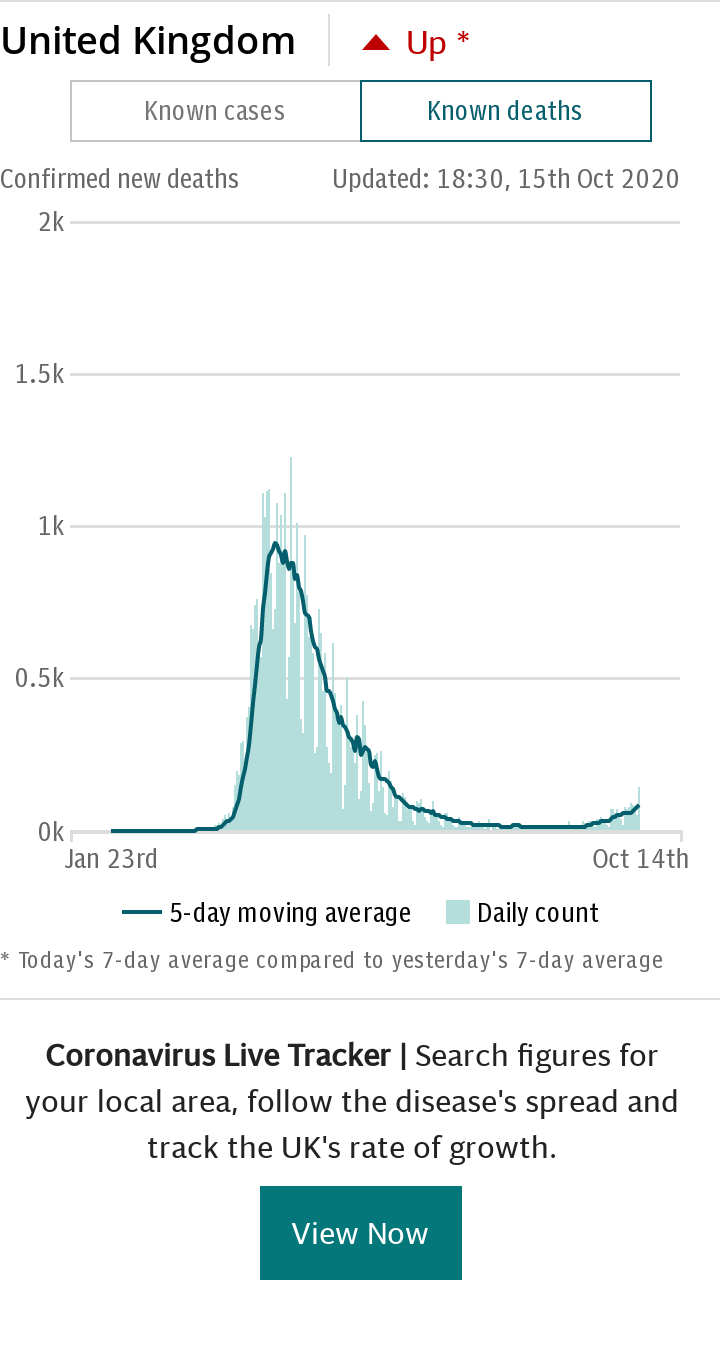Local lockdowns failing to slow the increase in coronavirus cases


Local lockdowns are not working to suppress the increase in coronavirus cases, analysis shows, with just one town managing to break free of restrictions, and most seeing instances continuing to rise.
Around one in four Britons are experiencing extra curbs on their movements, with many no longer able to socialise with friends, enjoy nights out after 10pm, or meet with family members who do not live in their home.
Some 48 towns, cities or districts are currently locked down, with a further six being given enhanced support, and 38 listed as areas of concern.
However, data compiled by the Telegraph shows that from the dozens of areas in lockdown, just Luton has been able to release measures.
Watch: Are you one of the 10 million Brits under extra restrictions because of local lockdown measures?
Stockport and Wigan, which were the only other two areas to successfully break free of restrictions, but both had measures reimposed on Friday.
Luton may also find itself back in lockdown once more, after recording recent spikes.
Elsewhere, all other local lockdowns are still in place, and all are seeing rises despite punitive restrictions.
The figures are troubling because they suggest that measures announced by Boris Johnson last week may do little to suppress the virus, at the expense of civil liberties and the economy.
Prof Hugh Pennington, Emeritus professor of bacteriology at the University of Aberdeen, said: “I have to agree that local measures are often having disappointing results. The same in Glasgow and surrounding areas.
“National lockdown using the same control measures would very likely have the same poor result. In my view all this shows that much more community testing is needed to identify cases and that contact tracing isn’t yet good enough.”
The data shows that although local lockdowns appear to have short term benefits, they do little to prevent the virus resurging, and according to experts, may lead to a bigger second wave.
Watch: What is a local lockdown?
Oldham in the North West, which was placed into lockdown on July 31, and had stricter measures banning household mixing imposed on August 22, is now recording huge weekly case numbers of 139 per 100,000.
Professor Carl Heneghan, director of the Centre for Evidence-based Medicine, Oxford University, said: “Oldham was a good example of where restrictions had little, or no impact, on what happened next.
“Attempting to reduce the numbers over the summer can have the counterproductive effect of increasing the susceptible population going into winter.
“We are now seeing rises across the country in line with the seasonal effect of going back to schools and universities, all of which is highly predictable and happens every year for circulating respiratory pathogens.”
On June 30, Leicester became the first area to face local restrictions when it was prevented from re-opening shops, bars and restaurants as the rest of the country slowly started to emerge from lockdown following a spike in cases.
By mid-August restrictions were slowly being lifted and cases had fallen to 27 per 100,000 per week. Yet by mid-September they had jumped back to 90 per 100,000, triggering even stricter measures which prevented people from mixing with people they did not live with.
Likewise, many areas in the North West which were locked down on July 31 were released at the start of September, only to have restrictions reimposed 16 days later.
By the end of July, Bury had seen cases fall to just nine in 100,000 people, but that has since increased 16-fold, at 144 in 100,000. At its lowest point, just one in 71 tests was coming back positive, but now that has risen to one in 15.
Salford, Tameside, Rochdale and Manchester have seen no relaxation of restrictions since they were imposed at the end of July, after numbers never fell significantly and have now started to rise again.
In Salford at the end of July just one in 40 tests were coming back positive, but that has since fallen to 13. Cases have also risen from 20 in 100,000 in July to 117 per 100,000 per week now.
In Tameside, just one in 47 tests was coming back positive in July, but now that has fallen to one in 13.
Robert Dingwall, Prof of Sociology, at Nottingham Trent University, said: “These figures do not give great confidence that the national measures announced this week will be successful, especially given the lack of evaluation.
“Since March, we should have been giving the evaluation of social interventions as much attention as we have been giving to evaluating therapies or vaccines. The rumoured ban on households meeting has no better basis of evidence beyond the desire to be seen to 'do something'."

Figures are undoubtedly being driven up, at least in part, by increased testing in hotspot areas. However, many areas, which appeared to be seeing improvements, have since been forced back into lockdown restrictions, often more harsh than the first time round.
Trafford and Bolton had restrictions lifted on September 2 (against the advice of local health officials) only for them to be reimposed 12 hours later. Bolton is now the worst area in the country at 196 cases per 100,000 per week.
Burnley also went back into lockdown on September 18 after being released at the beginning of the month.
In Rossendale, Lancashire, restrictions lifted on August 21 were reimposed on September 18, as cases jumped to 165 in 100,000 per week, the second worst area in the country.
Positive tests rocketed to such alarming levels in Calderdale, Bradford and Kirklees in West Yorkshire, that new restrictions were brought in on September 22 banning households from mixing at all. Hyndburn, Preston and Pendle in Lancashire and Blackpool have also suffered the same fate.
At the beginning of August, residents in Sandwell in the West Midlands were asked to voluntarily support extra restrictions by not letting people into their home. However, full local lockdown still needed to be imposed on September 15.
Watch: Why are some grandparents exempt from local lockdown rules?
On Sunday, the Welsh Government announced three more council areas in South Wales will go into local lockdown from 6pm on Monday.
Neath Port Talbot, Torfaen, and the Vale of Glamorgan will be covered by the restrictions, which mean people will not be able to enter or leave the areas without a reasonable excuse. It means more than 1.8 million people in Wales (nearly 60% the population) will be under local lockdowns.
Sam Williams, of Economic Insight, said it was clear that interventions were having no observable impact on the death rate.
“The impact of large scale policy interventions, especially blanket ones, is uncertain,” he said. “Most haven’t been implemented before, so we need to look at the data with care.
“It's early days, but the profile of deaths over time at a national level does not seem to be affected by the adding and removal of these measures (see chart below for an analysis of the UK's death rate). If they were having a very material impact, arguably it should be more readily observable.”

Behavioural scientists are concerned that the policies are ignoring the significant demographic and social differences between groups in Britain.
For example, they believe most transmission is happening in homes, but white families tend to have fewer children or elderly family members living with them.
In contrast, religious and ethnic minority communities live in far larger, multi-generational households, so limiting household contacts and imposing curfews on pubs are unlikely to drive down the virus much in those areas.
And while the Government believes strangers mingling at random are causing the spread, scientists say that most people go to pubs and restaurants in groups, and stay in those groups throughout the evening.

 Yahoo News
Yahoo News 